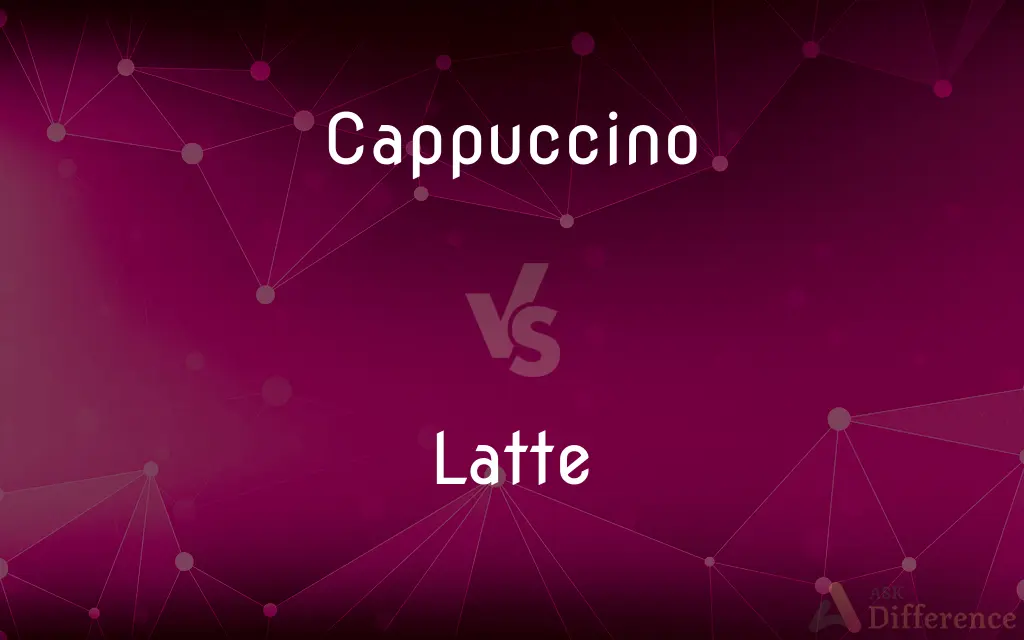Cappuccino vs. Latte — What's the Difference?
By Tayyaba Rehman — Updated on October 5, 2023
A cappuccino consists of equal parts espresso, steamed milk, and froth, while a latte has more steamed milk and less froth, creating a creamier drink. Both are popular espresso-based drinks but vary in milk and froth ratio.

Difference Between Cappuccino and Latte
Table of Contents
ADVERTISEMENT
Key Differences
A cappuccino is a beloved Italian coffee drink known for its equal parts of espresso, steamed milk, and milk froth, offering a robust coffee flavor balanced by the milk. In contrast, a latte, shortened from the Italian "caffè latte," meaning milk coffee, typically offers a milder experience with more steamed milk and a dash of froth atop, making it creamier and less intense than its counterpart.
While the cappuccino embraces a textural balance with its frothy upper layer providing a light and airy feel followed by a more potent espresso punch, the latte provides a silkier, smoother sip, where the espresso notes are softly enveloped by the prevalence of steamed milk. These texture and flavor nuances cater to varied preferences amongst coffee drinkers.
Crafting a cappuccino often involves precise technique to ensure the classic three-layer distinction, and mastering the frothing process is crucial. In making a latte, the barista's focus might steer towards achieving the perfect amalgamation of a generously milk-dominant and only slightly frothy concoction, ensuring that espresso is discernible yet subtly woven into the milky matrix.
Around the world, the cappuccino and latte have undergone various transformations, from the sizes served to additional flavor incorporations. Whether it's the large, flavored lattes popular in the United States or a classic Italian cappuccino enjoyed in a small cup, geographical location often influences the iterations of these drinks.
Visually, cappuccinos often present in a more segmented fashion, showcasing their frothy crowns, whereas lattes might present a more homogenous appearance, sometimes adorned with latte art crafted from the froth. These visual cues often act as the initial lure, appealing to both our sight and eventual taste experience.
ADVERTISEMENT
Comparison Chart
Basic Composition
Equal parts espresso, steamed milk, and froth
More steamed milk, a shot of espresso, and a bit of froth
Texture
Frothy and airy
Creamier and smoother
Flavor Intensity
Robust espresso flavor
Milder, with espresso subtly present
Typical Serving Size
Often smaller due to equal parts
Can be larger due to more milk
Popularity
Widely appreciated in Europe
Particularly popular in larger, flavored forms in the USA
Compare with Definitions
Cappuccino
An Italian coffee drink with equal parts espresso, steamed milk, and froth.
She ordered a cappuccino to enjoy the frothy texture.
Latte
Often milder and larger than a cappuccino due to the additional milk.
She enjoys a large latte in the morning.
Cappuccino
A beverage that sometimes features a dusting of cocoa or cinnamon on top.
The barista sprinkled cocoa over my cappuccino.
Latte
Commonly flavored with syrups like vanilla or caramel.
He ordered a vanilla latte.
Cappuccino
Recognizable by its distinct layered appearance.
The layers of the cappuccino were clearly defined.
Latte
A coffee drink made with espresso and more steamed milk, topped with a bit of froth.
I ordered a latte for a creamy coffee experience.
Cappuccino
Often smaller and more potent than other espresso drinks due to balanced parts.
He preferred a cappuccino for a strong coffee flavor.
Latte
Can be made iced for a cold coffee beverage.
On hot days, an iced latte is refreshing.
Cappuccino
Can be crafted using alternative milks like soy or almond.
They offer a delicious almond milk cappuccino.
Latte
Frequently adorned with latte art on the froth.
The barista crafted a heart in the froth of my latte.
Cappuccino
A cappuccino ( (listen); Italian pronunciation: [kapputˈtʃiːno]; Italian plural: cappuccini) is an espresso-based coffee drink that originated in Italy, and is simply prepared with steamed milk foam (microfoam).Variations of the drink involve the use of cream instead of milk, using non-dairy milk substitutes and flavoring with cinnamon or chocolate powder. It is typically smaller in volume than a caffè latte, with a thicker layer of microfoam.The name comes from the Capuchin friars, referring to the colour of their habits, and in this context referring to the colour of the beverage when milk is added in small portion to dark, brewed coffee (today mostly espresso).
Latte
Caffè latte (/ˌkæfeɪ ˈlɑːteɪ/ or /ˈlæteɪ/, Italian pronunciation: [kafˌfɛ lˈlatte] or [kafˌfe lˈlatte], often shortened to just latte in English, is a coffee drink of Italian origin made with espresso and steamed milk. The term comes from the Italian caffellatte (pronounced [kaffelˈlatte]) that is caffè e latte, literally "coffee and milk"; in English orthography either or both words sometimes have an accent on the final e (a hyperforeignism or to indicate it is pronounced, not the more-common silent final e of English).
Cappuccino
Espresso coffee mixed or topped with steamed milk or cream.
Latte
A type of coffee made with espresso and hot steamed milk, milkier than a cappuccino
He orders a croissant and a latte
Cappuccino
A serving of this beverage.
Latte
A caffe latte.
Cappuccino
(uncountable) An Italian coffee-based beverage made from espresso to which milk that has been steamed and/or frothed is added; (countable) a cup of this beverage.
Latte
A drink of coffee made from espresso and steamed milk, generally topped with foam.
Cappuccino
Any of various similar drinks.
Latte
A similar drink, where the espresso is replaced with some other flavoring ingredient such as chai, maté or matcha (green tea).
Cappuccino
A medium- to dark-brown colour like that of the coffee drink (sense 1) or the habit of a Capuchin monk.
Latte
Same as cafe latte; a type of espresso coffee served with foamy steamed milk, and usually served in a tall glass or mug.
Latte
Strong espresso coffee with a topping of frothed steamed milk
Common Curiosities
Are "cappuccino" and "latte" both Italian coffee drinks?
Yes, both cappuccino and latte originate from Italy and are known worldwide as popular espresso-based drinks.
What does "cappuccino" mean?
"Cappuccino" is derived from the Capuchin friars, referring to their brown habits which resemble the color of the coffee.
Is "latte" short for something in Italian?
Yes, "latte" means milk in Italian. A caffe latte translates to "milk coffee".
What is the main difference between a cappuccino and a latte?
The key difference lies in the ratio of espresso, steamed milk, and milk foam. Cappuccinos have more foam and lattes have more steamed milk.
Can alternative milk be used for cappuccinos and lattes?
Absolutely, alternatives like almond, soy, and oat milk are commonly used.
How is the foam different in cappuccinos and lattes?
Cappuccino has a denser and thicker foam, while lattes have a lighter and silkier foam.
Can cappuccino and latte be served cold?
Yes, while traditionally served hot, both can be made as iced versions.
Which has a stronger coffee flavor, cappuccino, or latte?
Cappuccinos tend to have a stronger coffee flavor due to the higher ratio of espresso to milk.
Are cappuccinos and lattes high in calories?
They can be, depending on the amount and type of milk used, but modifications can be made for lower-calorie versions.
Is a flat white the same as a latte?
No, a flat white is similar but typically has a higher espresso to milk ratio and a velvety microfoam.
What is the traditional size for a cappuccino and a latte?
Traditionally, a cappuccino is smaller, around 5-6 oz., while lattes can range from 10-20 oz.
Do cappuccinos and lattes always contain caffeine?
Yes, unless decaffeinated espresso is used in their preparation.
How are cappuccinos and lattes traditionally decorated or topped?
Lattes often have "latte art" on the foam surface, while cappuccinos might be sprinkled with chocolate or cinnamon.
How popular are cappuccinos and lattes worldwide?
Extremely popular. Both drinks are staples in coffee shops around the globe.
Is it acceptable to drink cappuccinos or lattes at any time of the day?
While in Italy cappuccinos are typically morning drinks, globally, they are enjoyed at any time.
Share Your Discovery

Previous Comparison
Narc vs. Nark
Next Comparison
Lie vs. MistruthAuthor Spotlight
Written by
Tayyaba RehmanTayyaba Rehman is a distinguished writer, currently serving as a primary contributor to askdifference.com. As a researcher in semantics and etymology, Tayyaba's passion for the complexity of languages and their distinctions has found a perfect home on the platform. Tayyaba delves into the intricacies of language, distinguishing between commonly confused words and phrases, thereby providing clarity for readers worldwide.













































